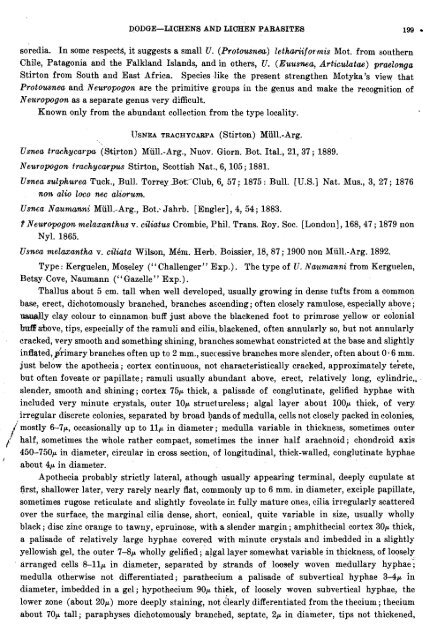Create successful ePaper yourself
Turn your PDF publications into a flip-book with our unique Google optimized e-Paper software.
j'<br />
DODGE-<strong><strong>LICHEN</strong>S</strong> <strong>AND</strong> <strong>LICHEN</strong> PABABITEB 199<br />
soredia. In some respect$, it suggests a small U. (Protcrus?~m) lethariiforntis Mot. from so~~thern<br />
Chile, Patagonia and the Falkland Islands, and in others, U. (Euuma, Articukztae) prwlonga<br />
Stirton from South and East Africa. Species like the present strengthen Motyka's view that<br />
Protownea and Neuropog-on are the primitive groups in the genus and make the recognition of<br />
h7eziropogolt as a separate genus very difficult.<br />
Known only from the abundant collection from the type locality.<br />
TJSNEA TRACHYCARPA (Stirton) Miill.-Arg.<br />
Uma trachycarpa (Stirton) Mull.-Arg., Nuov. Giorn. Bot. Ital., 21, 37 ; 1889.<br />
Neuropogon trachycarpm Stirton, Scottish Nat., 6,105; 1881.<br />
Usnea sulphurea Tuck., Bull. TorreyBotTClub, 6, 57; 1875 : Bull. [U.S.] Nat. Mus., 3, 27; 1876<br />
ncm alw loco nee aliorum.<br />
Usnca Naumami Mull.-Arg., Bot: Jahrb. [Engler] , 4, 54 ; 1883.<br />
B Neurqpogcm ntelazanthus v. ciliatw Crombie, Phil. Trans. Roy. Soc. [London], 168,47 ; 1879 non<br />
Nyl. 1865.<br />
Usnca melaxantha v. ciliata Wilson, MBm. Herb. Boissier, 18, 87 ; 1900 ilon Miill.-Arg. 1892.<br />
Type: Kerguelen, Moseley ("Challeilger" Exp.). The type of Ti. Nazbnlanni from Kergnelen,<br />
Betsy Cove, Naumann ("Gazelle" Exp.) .<br />
Thallus about 5 cm. tall when well developed, usually growing in dense tufts from a common<br />
base, erect, dichotomously branched, branches ascending; often closely ramulose, especially above ;<br />
W l y clay colour to cinnamon buff just above the blackened foot to primrose yellow or colonial<br />
bufF a-bove, tips, especially of the ramuli and cilia, blackened, often annularly so, but not annularly<br />
cracked, very smooth and something shining, branches somewhat constricted at the base and slightly<br />
inffated, &imary branches often up to 2 mm., successive branches more slender, often about 0.6 mm.<br />
just below the apothecia ; cortex continnous, not characteristically cracked, approximately terete,<br />
but often foveate or papillate; ramuli usually abundant above, erect, relatively long, cylindric,,<br />
slender, smooth and shining; cortex 75p thick, a palisade of conglutinate, gelified hyphae with<br />
included very minute crystals, outer lop structureless; algal layer about 100p thick, of very<br />
irregular discrete colonies, separated by broad bands of medulla, cells not closely packed in colonies,<br />
/ mostly 6-7p, occasionally up to llr in diameter; medulla variable in thickness, sometimes onter<br />
half, sometimes the whole rather compact, sometimes the inner half arachnoid; chondroid axis<br />
450-750p in diameter, circular in cross section, of longitudinal, thick-walled, conglutinate hyphae<br />
about 4p in diameter.<br />
Apothecia probably strictly lateral, athough usually appearing terminal, deeply cupulate at<br />
first, shallower later, very rarely nearly flat, commonly up to 6 mm. in diameter, exciple papillate,<br />
sometimes rugose reticulate and slightly foveolate ill fully mature ones, cilia irregularly scattered<br />
over the surface, the marginal cilia dense, short, conical, quite variable in size, usually wholly<br />
black ; disc zinc orange to tawny, epruinose, with a slender margin ; amphithecial cortex 30p thick,<br />
a palisade of relatively large hyphae covered with minute crystals and imbedsded in a slightly<br />
yellowish gel, the outer 7-8p wholly gelified ; algal layer somewhat variable in thickness, of loosely<br />
arranged cells 8-11p in diameter, separated by strands of loosely woven medullary hyphae;<br />
medulla otherwise not differentiated; parathecium a palisade of subvertical hyphae 3-4p in<br />
diameter, imbedded in a gel; hypothecium 90p thiek, of loosely woven subvertical hyphae, the<br />
lower zone (about 2OP) more deeply staining, not &early differentiated from the thecium; thecium<br />
about 70p tall; paraphyses dichotomously branched, septate, 2p in diameter, tips not thickened,

















